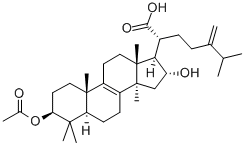| Description | Pachymic acid (PA) is a lanostane-type triterpenoid from Poriacocos, which is an important component in traditional Chinese medicine. Previous studies have shown that PA possesses anti-emetic, anti-inflammatory and anticancer properties. It has been demonstrated that PA is able to inhibit the proliferation and invasion of pancreatic cancer cells by decreasing MMP-7 expression. PA was able to activate reactive oxygen species (ROS)-dependent JUN N-terminal kinase mitochondrial and endoplasmic reticulum stress pathways following cell cycle arrest at G2/M phase and cell apoptosis occurred in lung cancer cells. PA reduced proliferation and induced apoptosis through inactivation of AKT signaling and downregulation of AKT downstream protein expression in prostate cancer cells. Another study demonstrated that PA is able to stimulate glucose uptake by enhancing the expression and translocation of glucose transporter type 4. However, the therapeutic effects and potential mechanisms of PA on gastric cancer are poorly understood and therefore remain to be evaluated. |
| Uses | Pachymic acid (PA) is a natural triterpenoid known to inhibit the phospholipase A2 (PLA(2)) family of arachidonic acid (AA)-producing enzymes, PA-treatment decreases bad phosphorylation, increases Bcl-2 phosphorylation, and activates caspases-9 and -3, it also decreases the expression and activation of proteins within the AKT signal pathway. suggests that PA initiates apoptosis through mitochondria dysfunction and influences apoptosis by reducing prostaglandin.
Pachymic acid can exhibit antiinflammatory and anticancer properties, it can inhibit cell growth and modulate arachidonic acid metabolism in nonsmall cell lung cancer A549 cells by its inhibition of MAPKs and NF-kappaB signaling pathways; it can impair breast cancer cell invasion by suppressing nuclear factor-κB-dependent matrix metalloproteinase-9 expression.
Pachymic acid has antioxidant activity, affects the removal effect of reactive oxygen species formation as did N-acetyl-L-cysteine and inhibits nuclear factor-κB translocation, it can mitigate the unfavorable conditions induced by AH Plus stimuli, therefore, the use of pachymic acid is suggested to prevent the complications of oral diseases such as inflammation and alveolar destruction of the oral cavity. |
| Uses | Pachymic Acid is a natural triterpene extract which suppresses invasiveness of pancreatic cancer cells through the downregulation of MMP-7. |
| Anticancer Research | Extracted from Poria cocos, pachymic acid (PA) is a tri-terpenoid (a lanostanetype), which is reported to have anticancerous properties. NCI-H460 and NCI-H23cells, the lung cancer cell lines, were studied for the effect of pachymic acid.Expression of a major UPR target gene-regulated protein, CHOP, was upregulatedresulting in cell apoptosis after PA treatment. It was discovered that ROS inhibitorsblocked the ER stress activation induced by PA. The results indicated that ROSproduction is also regulated by PA in lung cancer cells (Cheng et al. 2015; Jun et al.2015). As per the studies conducted on MIA PaCa-2 and PANC-1 cell lines,PA-induced apoptosis in pancreatic cancer cell resistant to gemcitabine wasdependent on in vivo and in vitro activation of ER stress. PA can be exploited for itsanticancer effects for treatment of pancreatic cancer resistant to chemotherapy(Cheng et al. 2015). |
